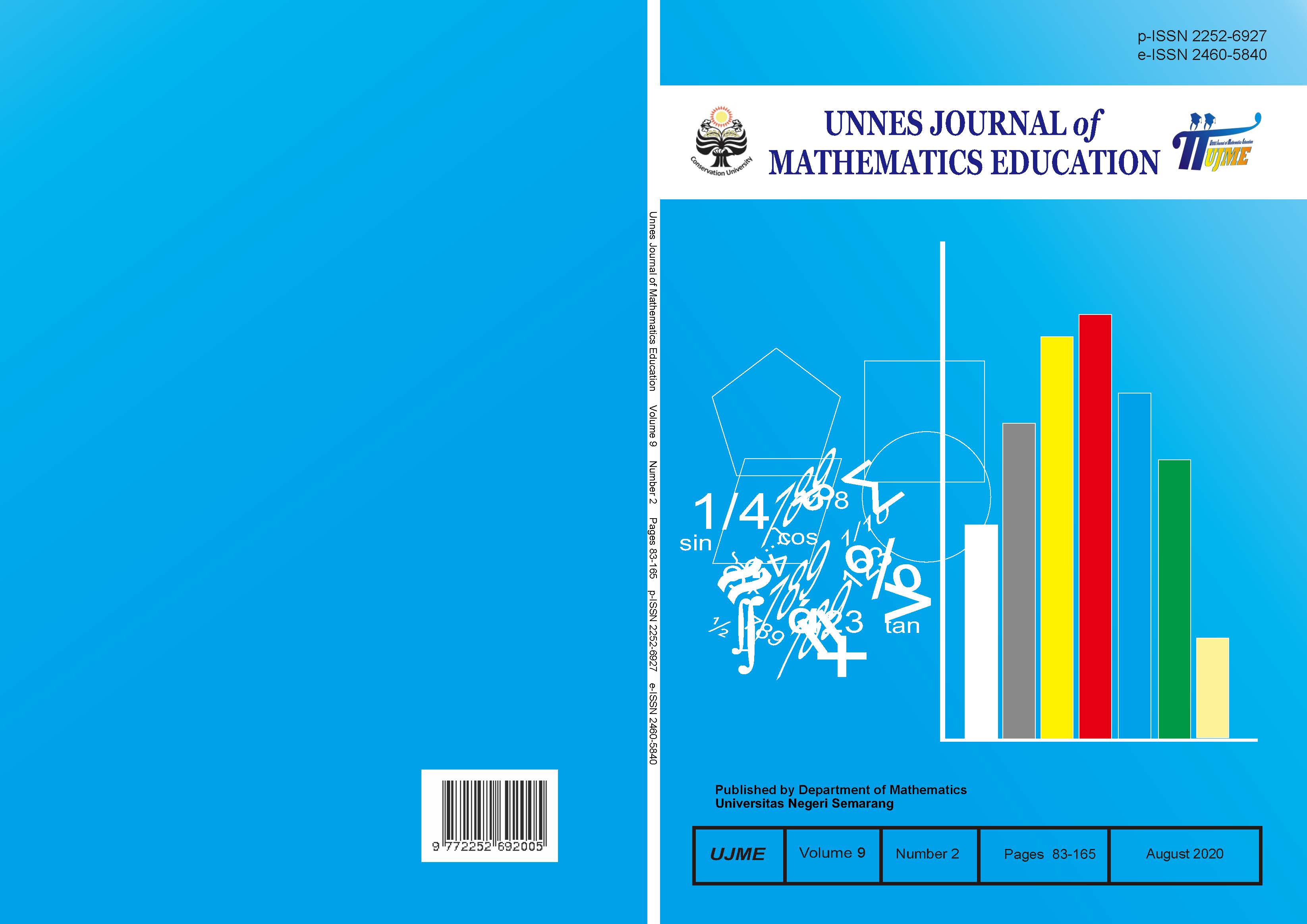Mathematical representation ability and curiosity of 8th graders in the 7E-Learning Cycle Model with realistic approaches
##plugins.themes.academic_pro.article.main##
Abstract
This study aimed to test the effectiveness of 7E-learning cycle learning with realistic approaches for students' mathematical representation ability and describe the students' mathematical representation ability from the view of students' curiosity. This study used a mixed-method with a concurrent embedded model. The population of this study was 8th graders in a Junior High School in Patebon, Kendal. Random sampling was used to obtain 32 students for the experiment class and 32 students for the control class. For the qualitative analysis, two students for each high, medium, and low curiosity level were selected. Questionnaires, tests, interviews, and documentation were used to collect data. T-test, classical completeness Z-test, the mean difference test, and proportions different tests were used to analyze the data quantitatively. Meanwhile, qualitative data were analyzed using data reduction, data display, conclusion drawing, and verification. The results show that 7E- learning cycle learning with realistic approaches affected students' mathematical representation abilities positively. The study also revealed that students with high, medium, dan low curiosity levels show different perform in mathematics representation.
##plugins.themes.academic_pro.article.details##
References
Belecina, R. R., & Ocampo, J. M. (2016). Mathematical Curiosity, Epistemological Beliefs, and Mathematics Performance of Freshman Preservice Teachers. Indonesian Journal for Educational Studies, 1(1), 123-136.
Ministry of National Education. (2006). Guidelines for the Compilation of Education Unit Level Curriculum. National Education Standards Agency: Jakarta.
Eisenkraft, A. (2003). Expanding the 5E model: A proposed 7E model emphasizes the "transfer of learning" and the importance of eliciting prior understanding. [Teacher Practitioner]. The Science Teacher, 70, 56-59.
Harjali. (2016). Teacher Strategies in Building a Conducive Learning Environment: Phenomenology Studies in Junior High School Classes in Ponorogo. Journal of Education and Learning, 23(1), 10-19.
Laelasari. (2014). The Application of Learning Cycle 7E Learning Model in Students' Mathematical Representation Ability. Euclid Journal, 1(2), 82-92.
Lestari, A. (2014). Application of a Realistic Mathematics Education Approach to Enhance Student Learning Outcomes on Story Matter Questions on Groups in Class VII MTsN Palu Barat. Electronic Journal of Mathematics Education Tadulako, 2(1), 1-11.
Mandur, K. (2013). The Contribution of Mathematical Connection, Representation, and Disposition Ability to the Mathematics Learning Achievement of Private High School Students in Manggarai Regency. e-Journal of Ganesha University Education Postgraduate Program.
Mullis, I. V. S., Martin, M. O., Foy, P., & Hooper, M. (2016). TIMSS 2015 International Result in Mathematics. Retrieved from Boston College, TIMSS & PIRLS Internasional Study Center.
NCTM. (2000). Principle and standards for School Mathematics. USA: NCTM.
Nurfauziyah, S., Marjono, & Sugiharto, B. (2015). The Implementation of Guided Inquiry to Improve Students' Curiosity in Biology Learning in Class XI IPA Al Muayyad High School Surakarta. Proceedings of the XII National Seminar on Biology Education FKIP UNS, 235-239.
OECD. (2016). PISA 2015 Result in Focus. Paris: OECD.
Pakarti, H. I. (2016). Effects of a Realistic Education Approach on Students' Mathematical Connection and Representation Ability on Comparison and Scale Materials. Journal of Scientific Pens, 1(1), 572-580.
Sahara, N. (2017). Development of Learning Tools Based on Realistic Mathematical Approaches to Improve Students' Mathematical Representation and Self Efficacy Abilities. Journal of Mathematics and Natural Sciences Research Research, 2(1), 141-152.
Setiawan. (2015). Experimentation of the 7E Learning Cycle Model with Problem Posing on Flat Side Space Building Material Judging from the Mathematical Learning Creativity of Grade VIII Students of State Junior High Schools in Mesuji Lampung Regency. Journal of Electronic Mathematics, 3(1), 1-11.
Sugiyono. (2015). Mixed Methods. Bandung: Alfabeta.
Suherman et al. (2003). Contemporary Mathematical Learning Strategies. Bandung: UPI.
Wicaksana, Y., Wardono, & Ridlo, S. (2017). Analysis of Mathematics Literacy Capabilities and Character of Student Curiosity in Project-Based Learning Assisted by Schoology. Unnes Journal of Mathematics Education Research, 6(2), 167-174.
Yudhanegara, M.R., & Lestari, K. E. (2015). Improving students' diverse mathematical representation abilities through open problem-based learning. Scientific Solutions, 1(4), 94-103.
